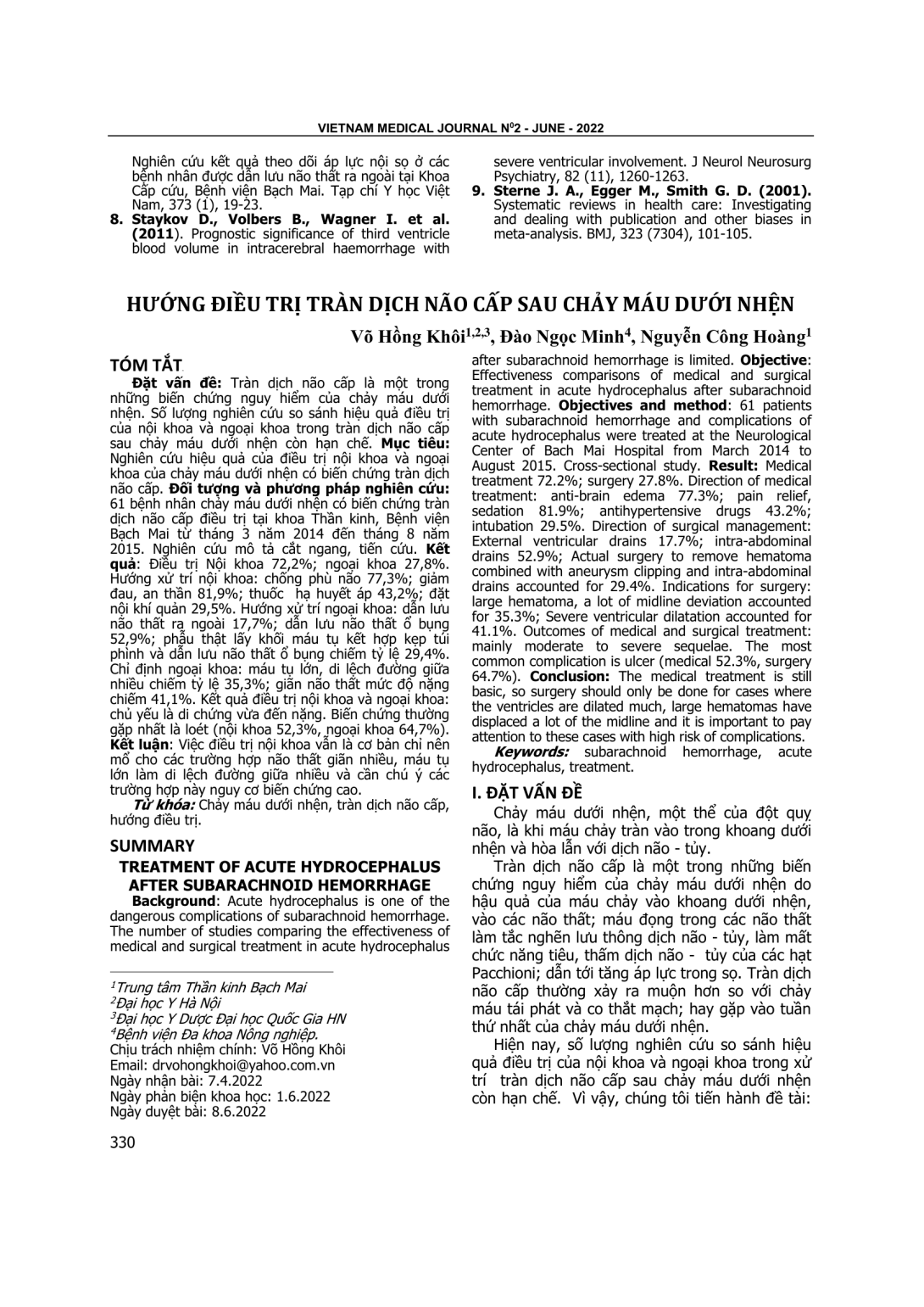
Tràn dịch não cấp là một trong những biến chứng nguy hiểm của chảy máu dưới nhện. Số lượng nghiên cứu so sánh hiệu quả điều trị của nội khoa và ngoại khoa trong tràn dịch não cấp sau chảy máu dưới nhện còn hạn chế. Mục tiêu: Nghiên cứu hiệu quả của điều trị nội khoa và ngoại khoa của chảy máu dưới nhện có biến chứng tràn dịch não cấp. Đối tượng và phương pháp nghiên cứu: 61 bệnh nhân chảy máu dưới nhện có biến chứng tràn dịch não cấp điều trị tại khoa Thần kinh, Bệnh viện Bạch Mai từ tháng 3 năm 2014 đến tháng 8 năm 2015. Nghiên cứu mô tả cắt ngang, tiến cứu. Kết quả: Điều trị Nội khoa 72,2%; ngoại khoa 27,8%. Hướng xử trí nội khoa: chống phù não 77,3%; giảm đau, an thần 81,9%; thuốc hạ huyết áp 43,2%; đặt nội khí quản 29,5%. Hướng xử trí ngoại khoa: dẫn lưu não thất ra ngoài 17,7%; dẫn lưu não thất ổ bụng 52,9%; phẫu thật lấy khối máu tụ kết hợp kẹp túi phình và dẫn lưu não thất ổ bụng chiếm tỷ lệ 29,4%. Chỉ định ngoại khoa: máu tụ lớn, di lệch đường giữa nhiều chiếm tỷ lệ 35,3%; giãn não thất mức độ nặng chiếm 41,1%. Kết quả điều trị nội khoa và ngoại khoa: chủ yếu là di chứng vừa đến nặng. Biến chứng thường gặp nhất là loét (nội khoa 52,3%, ngoại khoa 64,7%). Kết luận: Việc điều trị nội khoa vẫn là cơ bản chỉ nên mổ cho các trường hợp não thất giãn nhiều, máu tụ lớn làm di lệch đường giữa nhiều và cần chú ý các trường hợp này nguy cơ biến chứng cao.
Acute hydrocephalus is one of the dangerous complications of subarachnoid hemorrhage. The number of studies comparing the effectiveness of medical and surgical treatment in acute hydrocephalus after subarachnoid hemorrhage is limited. Objective: Effectiveness comparisons of medical and surgical treatment in acute hydrocephalus after subarachnoid hemorrhage. Objectives and method: 61 patients with subarachnoid hemorrhage and complications of acute hydrocephalus were treated at the Neurological Center of Bach Mai Hospital from March 2014 to August 2015. Cross-sectional study. Result: Medical treatment 72.2%; surgery 27.8%. Direction of medical treatment: anti-brain edema 77.3%; pain relief, sedation 81.9%; antihypertensive drugs 43.2%; intubation 29.5%. Direction of surgical management: External ventricular drains 17.7%; intra-abdominal drains 52.9%; Actual surgery to remove hematoma combined with aneurysm clipping and intra-abdominal drains accounted for 29.4%. Indications for surgery: large hematoma, a lot of midline deviation accounted for 35.3%; Severe ventricular dilatation accounted for 41.1%. Outcomes of medical and surgical treatment: mainly moderate to severe sequelae. The most common complication is ulcer (medical 52.3%, surgery 64.7%). Conclusion: The medical treatment is still basic, so surgery should only be done for cases where the ventricles are dilated much, large hematomas have displaced a lot of the midline and it is important to pay attention to these cases with high risk of complications.
- Đăng nhập để gửi ý kiến
